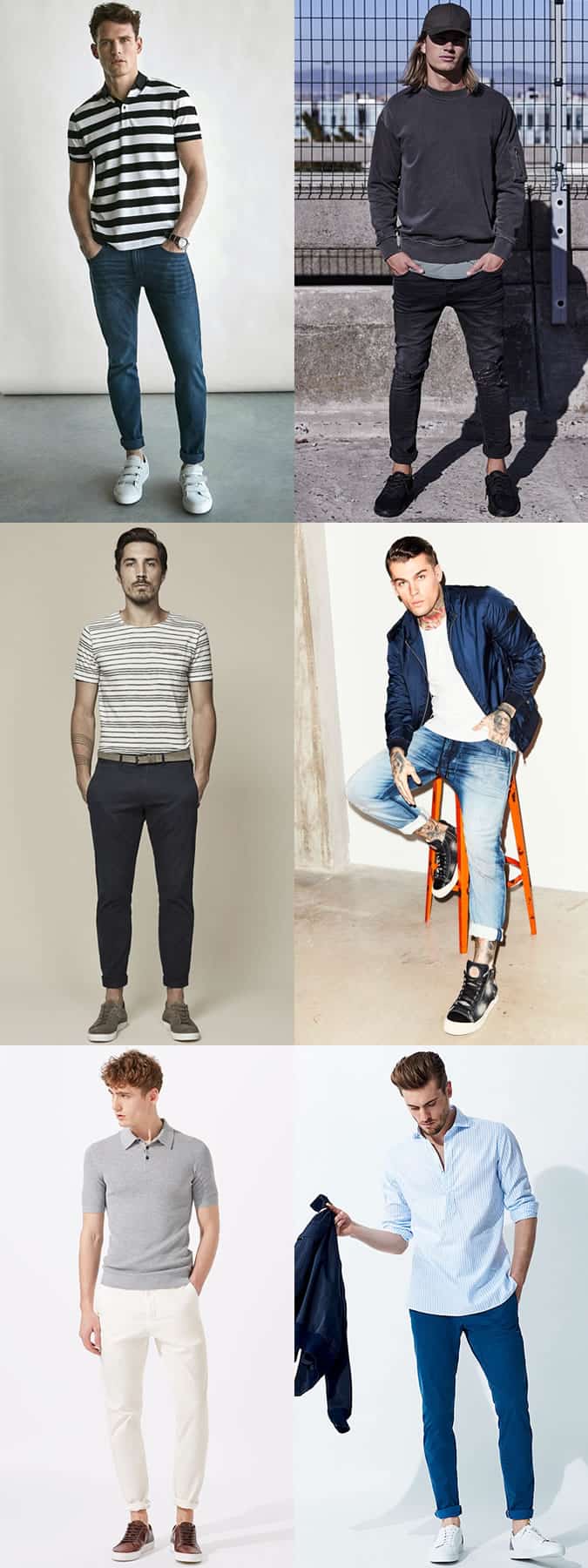As modern man-skills go, this one’s up there with learning to write a good Tinder bio and getting a barman’s attention. A staple smart-casual move, there are lots of reasons to pinroll your jeans, and lots of ways it can go awry. But get it right, and it’s a fallback style trick to boost almost any denim-clad look.
Also known as French rolling, pegging and raga rolling, pinrolling isn’t just a case of haphazardly rolling up your jeans. While cuffing – folding the cuff of your trousers up just once – will shorten the length, pinrolling also tapers them. That means it’s a bit more of a complicated process – but still one you can master in minutes.
Seeing every sneakerhead on Instagram do it, it’s tempting to think that pinrolling is a relatively new way to style your denim. In truth, it’s like most things in menswear – tried and tested by your father and grandfather. It first grew in popularity in the 1950s, mainly among working class men. Since then it’s been in and out of the limelight from 1970s Travolta to 1980s Tom Cruise. Google some pictures of New Kids On The Block and you’ll see how fresh this trend really is.
Not that the history matters, of course. Ever since trainers became something to show off, the trend has never gone away. Today, it’s a style staple for streetwear and smart-casual types alike. So here’s your guide on exactly how to pinroll and how to style pinrolled jeans.
Why You Should Pinroll Your Jeans
The main advantage of pinrolling is that it gives you better control over where your jeans end. That means no Steve Jobs-style bunching around your ankles, and no obscuring the limited edition footwear you camped overnight to secure. If you’re tall, pinrolling creates a much-needed visual break on a lanky lower body and if you’re short, it stops your jeans from looking too big for you.
There are other benefits, too. Pinrolling will make your calves look a bit bulkier, so it’s ideal if your thighs are more muscular and you want to balance things out. The extra tapering effect looks stylish and smart, and it’s good for showing off your socks or ankles. If you’re wearing selvedge denim – and you should be – it subtly shows everyone the telltale woven strip on the outer seam.
And yes, pinrolling is also the best framing device for your footwear. Whether it’s a new sneaker or the finest brogues in all the land, the cuff naturally draws eyes down toward your feet. Plus, if you’re wearing a pristine pair of white trainers, it’ll also save you from the tragedy of indigo dye running into them.
How To Pinroll
That’s the theory, here’s the practical. To start off with, make sure that the trousers or jeans you want to pinroll are slim, straight or tapered, but not too skinny. There needs to be a little bit of room for manoeuvre here, so spray-on fits won’t do (frankly, they never do). Now follow these steps for a perfect pinroll:
- First, take the inner part of the bottom of your jeans, and pull it tight around the ankle. Fold backwards so that the inner seam is at the back of the fold, facing out.
- Make the fold as tight as possible (without cutting off your circulation) then fold upwards, making sure you keep the initial fold intact.
- Now fold the cuff all the way around your leg, remembering that it’s important to keep it all looking neat and avoid it getting too bulky. The fold itself should be one-to-two inches high.
- Now repeat. Two folds should be enough, depending on the length of your jeans.
- Straighten out any curves or kinks, then get to work on the other leg.
That’s essentially how it’s done. For a more statement look, you can roll them up higher – the length is something to experiment with, but be aware the the more you roll, the thicker the folded denim becomes.
To keep things symmetrical – make sure you fold from the right when you roll the left leg, and from the left on the right leg.
How To Style Pinrolled Jeans
Denim works best for pinrolling because it’s most likely the sturdiest material you’ll find in your wardrobe. Stiff denim (preferably selvedge) is even better for holding the shape – and the extra weight at the bottom of your legs will make your jeans hang better.
That said, chinos also work well with pinrolling – but the lighter material makes them slightly more likely to unravel so keep the fold as tight as possible. Stay away from pinrolling dress trousers – this look is designed to be informal and lightweight cotton just won’t hold the shape.
Pinrolling isn’t enough to save dad jeans, either. It’ll only make things worse because the excess material will only bunch and look heavy. Nineties hip-hop fashion might be back, but you don’t want to look like you’re going to a Boyz II Men concert. Straight-leg cuts are about your limit but even then, slimmer styles work better. Looser legs or (whisper it) bootcut styles will be more difficult because they have a wider hem and will be tougher to pinroll neatly and get a good effect from.
Pinrolling works best with casual outfits. A plain jumper, shirt or T-shirt is a good call. If you’re unsure, simply pinroll one side of your trousers and stand to the side as you try on different tops in the mirror.

What Shoes To Wear With Pinrolled Jeans
Picking what jeans to pinroll is only half the battle. Deciding what shoes to team with your pinrolled jeans is also a skill. Hero trainers are the obvious choice because the trend is designed to show them off in all their glory.
More formal styles of footwear can work well too. Boat shoes, loafers, smarter boots and brogues all look good under the right pair of jeans or chinos. We’d argue that Oxfords are a shade too formal and sandals just clash for some reason.
The general advice is to not team your shoes with socks, and let those (m)ankles see the light of day. Go for a trainer sock to prevent the need to peg your nose as well as your trousers. And if you really want to show off some hosiery, stick to something tonal that works with the denim or something statement like a luxe pair of outdoors-inspired socks.








